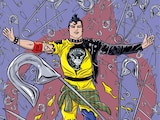As I was watching Birds of Prey, I found myself focusing on Renee Montoya. All of the birds were dynamic, but Montoya was the one who really grabbed my attention. While the comics version of Montoya is younger than actress Rosie Perez, I love that the movie aged her up. While it’s often true that comic fans hate it when characters are changed for the movies, in this case, it helped broaden the perspectives onscreen, and Perez absolutely crushed the role.
When I saw the Birds of Prey preview poster months earlier, I assumed that Montoya would be pushed to the background as more of a mother figure. Hollywood never puts women in their fifties front and center during action movies. To my pleasant surprise, Renee Montoya was just as prominent as the other Birds…and did her own share of butt-kicking. It was a refreshing change from the Hollywood norms, and best of all, they nailed Montoya’s characterization.

Like her comic book counterpart (more on her later) Renee struggled to prove herself to a police department of men, where she was overlooked because she was a woman, a lesbian and Hispanic. Her life isn’t going well and Renee has resorted to drinking. Remember Harley’s reaction when Montoya showed up to the final battle drunk? It’s a good thing she sobered up fast, because she fought like a badass.
During the ending montage, we see Montoya take a sip from her flask as she quits her job. The movie ends without a resolution to Montoya’s struggle with alcoholism, and that’s okay. Alcoholism is a serious problem that can take years to solve, and it doesn’t just go away after two hours. Defeating Black Mask and standing up to her superiors doesn’t mean all of Montoya’s problems are over, and that’s one reason why her story stuck with me.
It was so important to me that the Birds of Prey movie got Montoya right because of her legacy in both comics and animation. Like her co-star Harley Quinn, Montoya also got her start on Batman: The Animated Series, but with an interesting twist. DC’s publishing team learned about the young Latina police officer that would be featured in the cartoon and they loved the idea, so DC decided to add Renee Montoya to their comic continuity. Animation takes a long time to produce, which meant that even though Renee began in animation, Bat-Fans first met Montoya in the pages of Batman #475 months before she made her Batman: The Animated Series debut in the episode “Pretty Poison.”

On the series, Montoya played the straight person while her partner Harvey Bullock was the buffoon, resulting in some great comedic moments. While Montoya wasn’t featured as heavily as other female characters like Batgirl or Catwoman, she was a great example of a strong character, and her contribution to Batman: The Animated Series is often underrated and overlooked. Watch her in the episode “Harley and Ivy” where she takes down Poison Ivy and Harley Quinn, something that even Batman and the Joker couldn’t do. Pay close attention to her during the episode “Holiday Knights.” Montoya comes off as brave, assertive and creative. She may have been a minor character on the show, but she was fleshed out into a fully realized person.
Most of Montoya’s best comic book moments come from a series called Gotham Central. Readers, I am not exaggerating when I say that Gotham Central is one of the greatest comic series ever produced. It won numerous awards, including an Eisner for Best Serialized Story, and was a heavy inspiration for the television show Gotham (at least the first, earliest season). Gotham Central, written by Greg Rucka and Ed Brubaker and drawn by an art team that included Michael Lark and Stefano Gaudiano, is a gritty look at life in the Gotham City Police Department. It focuses on how the officers of the GCPD solve crimes and deal with government bureaucracy without Batman.

During the series, readers learned that Montoya was a lesbian, and unfortunately, she wasn’t outed on her own terms. Two-Face had fallen in love with Montoya and thought she would return his affections if she had nowhere else to go. Two-Face attempted to destroy Renee’s life by outing her, and he succeeded. Photographs of Renee with her girlfriend Daria were posted around the GCPD, humiliating her. Renee’s religious family did not accept her sexuality, which deeply wounded her. Like I said folks, sh*t got real over in Gotham Central. Like her movie counterpart, Renee didn’t always get a happy ending.
After Gotham Central ended and Renee quit the GCPD, her story continued in the maxi-series 52, where she was trained by Vic Sage and took on the mantle of the Question. The series is also notable for introducing an old flame of Renee’s named Kate Kane. Yes, THAT Kate Kane. As Renee was becoming the Question, her ex-girlfriend Kate became Batwoman. The two have occasionally partnered as vigilantes and are currently giving their relationship another shot.
We’ll see if it works out because after a whole lot of drama, Renee Montoya deserves a little happiness. For now, though, I’m calling Rosie Perez’s performance as her a big win. It’s been a long journey for this Bird with a badge, and I can’t wait to see where she goes next.

Birds of Prey (And the Fantabulous Emancipation of One Harley Quinn) is now in theaters. Click here to get tickets!
Joshua Lapin-Bertone writes about TV, movies and comics for DCComics.com and DCUniverse.com, is a regular contributor to the Couch Club and writes our monthly Batman column, "Gotham Gazette." Follow him on Twitter at @TBUJosh.















